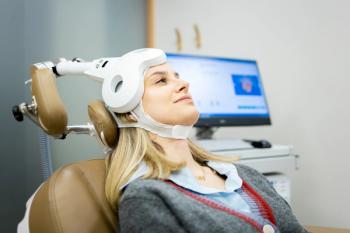
Then and Now: Addressing Comorbid PTSD and MDD
The authors examine recent literature in order to assist psychiatrists in evaluating the findings and determining how to best put research findings into real-world practice.
JOURNAL CLUB
Major depressive disorder (MDD) is a prevalent and
In a secondary analysis of a
Structured Question
Question. Should a concurrent PTSD diagnosis affect whether to augment or switch medications when MDD has not responded to a prior antidepressant trial?
Type of study. Secondary analysis of a randomized, single-blind, parallel-assignment trial (ClinicalTrials.gov identifier: NCT01421342).5 (Note: This clinical trial is the 2017
Population. Participants included1522 Veterans Health Administration (VA) patients from 35 study sites who experienced suboptimal response to at least 1 course of selective serotonin reuptake inhibitor/serotonin-norepinephrine reuptake inhibitor/mirtaza-pine antidepressant treatment meeting minimal standards for dose and duration.5 Patients were primarily men (85.2%) with a mean age of 54.4. A total of 717 participants (47.1%) had a co-occurring PTSD diagnosis. Patients all had a diagnosis of non-psychotic MDD and were referred by their VA clinicians.
Exposures. Study assignment was random (1:1:1) to 3 treatment strategies: switch to bupropion (switch-BUP); augment current antidepressant with bupropion (aug-BUP); or augment current antidepressant with aripiprazole (aug-ARI).
Method. Between December 2012 to May 2015, participants underwent 12 weeks of treatment with either switch-BUP (n = 511), aug-BUP (n = 506), or aug-ARI (n = 505). Blinded ratings with the 16-item Quick Inventory of Depressive Symptomatology-Clinician Rated (QIDS-C16) determined remission (less than or equal to a score of 5) and response (reduction in score from baseline by 50% or more) by 12 weeks and relapse after remission (score of 11 or more for those who previously achieved remission). Long-term follow up lasted up to 24 weeks. Survival analyses compared treatment effects in patients with concurrent PTSD and those without it.
Statistical analysis. Remission and response outcomes for patients with and without comorbid PTSD were compared using Cox regression modelswith comorbid PTSD and treatment as independent variables with an interaction term for treatment and PTSD. Multivariable Cox regression models were developed using stepwise regression in which significant predictors of outcome that were associated with PTSD were added to the models to adjust estimates of PTSD and treatment effects for covariates. Comparisons were expressed by relative risk ratios (RR) estimated from hazard ratios from Cox models and 95% confidence intervals (CI), reporting the Wald test P values.
Results
From the
Comparing the impact of a PTSD comorbidity
A greater proportion of African American and Hispanic patients were found in the comorbid PTSD group. Overall, patients with comorbid PTSD had more severe depressive symptoms on the QIDS as well as global clinical severity indexes and lower quality of life scores.
In terms of retention, 27.6% of the 717 participants with PTSD withdrew from the study before the 12 week completion compared to 23.2% of those without PTSD. The difference in dropout rates for those with PTSD versus those without PTSD was greatest in the aug-BUP group (29.5% versus 21.4%, respectively) but similar in the switch-BUP and aug-ARI groups.
In terms of remission, at 12 weeks there was a 43% lower risk of remissionfor those with comorbid PTSD (RR = 0.567; 95% CI, 0.462–0.697) with all 3 treatments, irrespective of the severity of MDD. Kaplan-Meier plots of cumulative probability of remission for each treatment group by PTSD status show remission rates are lower in the PTSD group; the switch-BUP treatment group had the lowest rate of remission.
Relative risk of response was also significant for those with PTSD (RR = 0.745; 95% CI, 0.658–0.843) and for each of the 3 treatments, reflecting a 25% lower symptom improvement among those with PTSD. For relapse after remission, the risk was not significantly greater among those with PTSD. The results across treatment groups were mixed, with significantly greater likelihood of relapse among participants with PTSD in the aug-BUP group but not among those in the switch-BUP or aug-ARI groups.
Comparing the impact of various treatment interventions
A comparison of the magnitude of treatment effects between pairs of treatments (risk ratios reflecting comparative effectiveness of paired treatments) among patients with and without
There were no significant differences in response between augmentation with aripiprazole and augmentation with bupropion in either patients with PTSD or patients without PTSD. The analysis of relapse showed no significant differences between pairs of treatment groups with or without PTSD and minor interaction of treatment group and PTSD diagnosis (P = .15).
The bottom line
In this population of older,
Comments
There were several limitations of the 2020 study. First, it was conducted within the VA system with a predominantly older male population with likely combat-related trauma histories. It is thus unclear whether results would generalize to the broader population with other underlying PTSD forms.
Second, despite inclusion of a greater proportion of participants with non-psychotic psychiatric comorbidities, there were still a number of exclusion criteria, including active substance use, which represents a significant comorbidity found in patients with MDD.
Third, all individuals included experienced a moderate degree of depression severity; hence, these findings cannot be extrapolated in the care of patients with mild and severe MDD.
Fourth, 26% of participants did not complete the study, resulting in a substantial dropout rate. It is also possible that the group that switched to bupropion may have experienced withdrawal from previous treatment, putting them at a disadvantage for dropout or other adverse outcomes.
Fifth, only 1 antidepressant and 1 antipsychotic were evaluated. Generality to other agents is unknown, especially to factors such as behavioral interventions, tricyclic antidepressants, monoamine oxidase inhibitors, electroconvulsive therapy, transcranial magnetic stimulation, and lithium augmentation.
Lastly, although there was no financial support from industry, authors disclosed some pharmaceutical affiliations, which may potentially lead to biases.
Dr Stanciu is assistant professor of psychiatry at Dartmouth’s Geisel School of Medicine and Director of Addiction Services at New Hampshire Hospital, Concord, NH. He is Addiction section editor for Psychiatric Times. Dr Gnanasegaram is instructor in psychiatry at Dartmouth’s Geisel School of Medicine and Attending Psychiatrist at New Hampshire Hospital, Concord, NH. The authors report no conflicts of interest concerning the subject matter of this article.
References
1. Horton R.
2. Trivedi MH, Rush AJ, Wisniewski SR, et al; STAR*D Study Team.
3. Kessler RC, Berglund P, Demler O, et al.
4. Post LM, Zoellner LA, Youngstrom E, Feeny NC. Understanding the relationship between co-occurring PTSD and MDD: symptom severity and affect. J Anxiety Disord. 2011;25(8):1123-1130.
5. Mohamed S, Johnson GR, Chen P, et al.
6. Mohamed S, Johnson GR, Sevilimedu V, et al.
This article was originally posted on August 5, 2020 under the title "Then and Now: Addressing Comorbid PTSD and MDD," and has since been updated. -Ed
Newsletter
Receive trusted psychiatric news, expert analysis, and clinical insights — subscribe today to support your practice and your patients.














